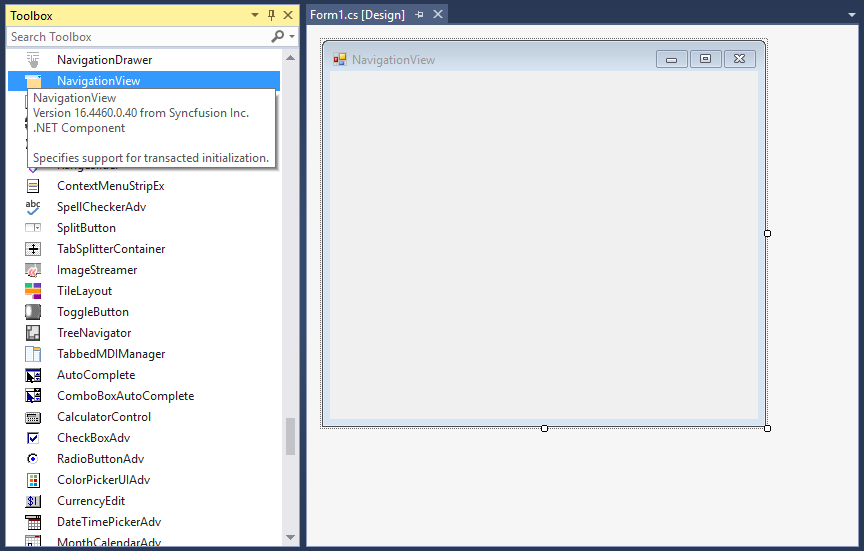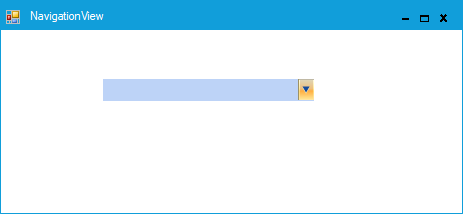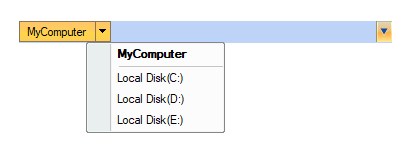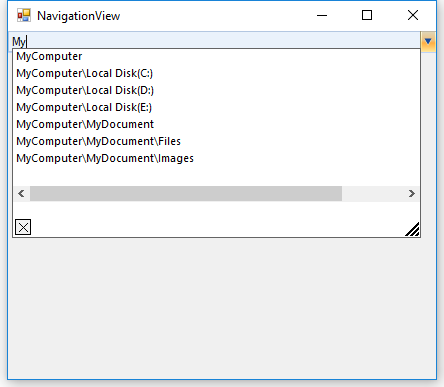Getting Started with Windows Forms NavigationView
4 Feb 20254 minutes to read
Assembly deployment
Refer to the control dependencies section to get the list of assemblies or NuGet package that needs to be added as a reference to use the control in any application.
You can find more details about installing the NuGet packages in a Windows Forms application in the following link:
Create a simple application with NavigationView
You can create a Windows Forms application with NavigationView control using the following steps:
Create a project
Create a new Windows Forms project in Visual Studio to display the NavigationView control with breadcrumbs nodes.
Add control via designer
The NavigationView control can be added to an application by dragging it from the toolbox to a designer view. The following required assembly references are added automatically to the project:
- Syncfusion.Grid.Base.dll
- Syncfusion.Grid.Windows.dll
- Syncfusion.Shared.Base.dll
- Syncfusion.Shared.Windows.dll
- Syncfusion.Tools.Base.dll
- Syncfusion.Tools.Windows.dll

Add control manually using code
To add the control manually in C#, follow the given steps:
-
Add the following required assembly references to the project:
- Syncfusion.Grid.Base.dll
- Syncfusion.Grid.Windows.dll
- Syncfusion.Shared.Base.dll
- Syncfusion.Shared.Windows.dll
- Syncfusion.Tools.Base.dll
- Syncfusion.Tools.Windows.dll
-
Include the Syncfusion.Windows.Forms.Tools namespace.
using Syncfusion.Windows.Forms.Tools;Imports Syncfusion.Windows.Forms.Tools -
Create a NavigationView instance, and add it to the window.
NavigationView navigationView1 = new NavigationView(); navigationView1.Width = 100; navigationView1.Height = 20; this.Controls.Add(navigationView1);Dim navigationView1 As New NavigationView() navigationView1.Width = 100 navigationView1.Height = 20 Me.Controls.Add(navigationView1)

Add breadcrumb nodes
To add root bar, create a new instance to bar, and add it to the Bars collection property in NavigationView. To add child bar, create an instance, and add it to the Bars collection property in its root bar.
Bar bar1 = new Bar();
Bar bar2 = new Bar();
Bar bar3 = new Bar();
Bar bar4 = new Bar();
bar1.Text = "MyComputer";
bar2.Text = "Local Disk(C:)";
bar3.Text = "Local Disk(D:)";
bar4.Text = "Local Disk(E:)";
// Adding root Bars
this.navigationView1.Bars.AddRange(new Bar[] { bar1 });
// Adding child Bars
bar1.Bars.AddRange(new Bar[] {bar2, bar3, bar4});
// Set selected Bar
this.navigationView1.SelectedBar = bar1;Dim bar1 As Bar = New Bar()
Dim bar2 As Bar = New Bar()
Dim bar3 As Bar = New Bar()
Dim bar4 As Bar = New Bar()
bar1.Text = "MyComputer"
bar2.Text = "Local Disk(C:)"
bar3.Text = "Local Disk(D:)"
bar4.Text = "Local Disk(E:)"
' Adding root Bars
Me.navigationView1.Bars.AddRange(New Bar[] { bar1 })
' Adding child Bars
bar1.Bars.AddRange(New Bar[] {bar2, bar3, bar4})
' Set selected Bar
Me.navigationView1.SelectedBar = bar1
Edit mode
Selected path of navigation view can be changed by editing the text with valid navigation path.
